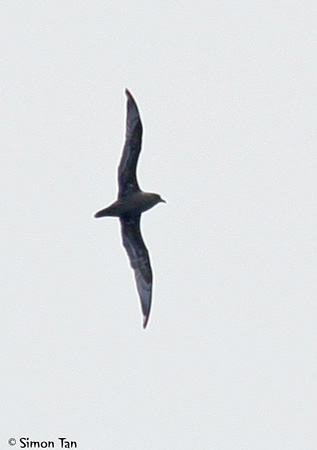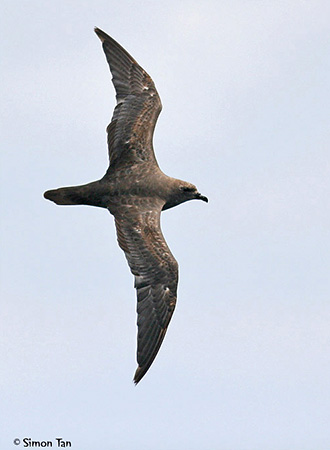
PROTECTION / THREATS / STATUS:
The Herald Petrel is threatened by predation by cats and rats at several colonies, when the birds come ashore to breed or to visit their nests.
On the Pitcairn Islands where the vast majority of the population breeds, the breeding habitat may be affected due to changing sea levels and increase in sea temperature. The population on Henderson Island represents about 20% of the global population, but the majority of the population breeds on Ducie Island from which rats were eradicated in 1997.
The species is widespread but probably uncommon. The overall population is estimated at 150,000 individuals, and it is suspected to be declining.
The Herald Petrel is currently evaluated as Least Concern.
Fr: Pétrel du Herald
Ang: Herald Petrel
All: Heraldsturmvogel
Esp: Petrel del Herald
Ita: Petrello di Tonga
Nd: Salvins Stormvogel
Sd: heraldpetrell
Photographer:
Simon Tan
PBase Bird galleries
Illustrator:
John Gerrard Keulemans: 1842-1912
Illustration’s origin:
Godman, 'Monograph of the Petrels,' 1909
Text by Nicole Bouglouan
Sources:
HANDBOOK OF THE BIRDS OF THE WORLD vol 1 by Josep del Hoyo-Andrew Elliot-Jordi Sargatal - Lynx Edicions - ISBN: 8487334105
The dark-morph Herald Petrel Pterodroma heraldica
Queensland Government - Herald petrel
First records of Herald Petrel 'Pterodroma heraldica' on Phillip Island (Norfolk Island Group)
Herald petrel arrives on Phillip Island
Nest-site selection by the Herald Petrel and White-tailed Tropicbird on Round Island, Indian Ocean.
Wikipedia, the free encyclopaedia
Herald Petrel
Pterodroma heraldica
Procellariiformes Order – Procellariidae Family
INTRODUCTION:
The Herald Petrel has very wide range in tropical and subtropical Pacific Ocean. It is a pelagic seabird that comes ashore only to breed. It can be seen covering hundreds of kilometres over the ocean while searching for food.
This species breeds in loose colonies established on oceanic islands and atolls. The eggs are laid on cliff ledges, ridges or rocky slopes, often under some vegetation. It breeds in Melanesia and Polynesia.
It feeds on small fish, squid and crustaceans. It searches for food by gliding over ocean waters while using three hunting behaviours including contact-dipping, surface-plunging and aerial pursuit.
The Herald Petrel shows three forms of plumages such as dark, light and intermediate morphs. The difference occurs mainly from lower breast to undertail-coverts, with a gradation in plumage colour from dusky to darkish and in between.
The Herald Petrel is affected by predation by cats and rats during the breeding period, especially on Henderson Island (South Pacific) which represents about 20% of the global population.
The species is widespread but uncommon. It is not globally threatened at the moment and currently evaluated as Least Concern.
The name of the species pays tribute to the ship “HMS Herald” which participated to the early explorations of the region where this bird was first studied, and undertook surveys in the south-west Pacific during 1852-61.
DESCRIPTION OF THE BIRD:
Biometrics:
Length: 35-39 cm
Wingspan: 88-102 cm
Weight: 237-320 g

The Herald Petrel in dark morph (displayed) has dark grey-brown coloration, sometimes appearing warmer brown in strong sunlight.
Head and neck are dark grey-brown contrasting slightly with the paler underparts. The throat varies from whitish to dusky, with some dark feathers. The upper breast shows a broad, diffuse dark breast band. The area from lower breast to undertail-coverts is rather uniformly darkish grey-brown, whereas flanks and undertail-coverts are slightly darker.
On the underwing, axillaries, wingtips, leading and trailing edges are blackish. Large white patches are visible on the underwing-coverts. Undertail feathers are dark brown.
The Herald Petrel in intermediate morph: the palest intermediates approach the light morph, whereas the darkest approach the dark morph.
The key difference from light morph is that the area extending from breast to undertail-coverts is at least wholly dusky.
It differs from dark morph by a relatively clear border between the dark upper breast and the paler lower breast.
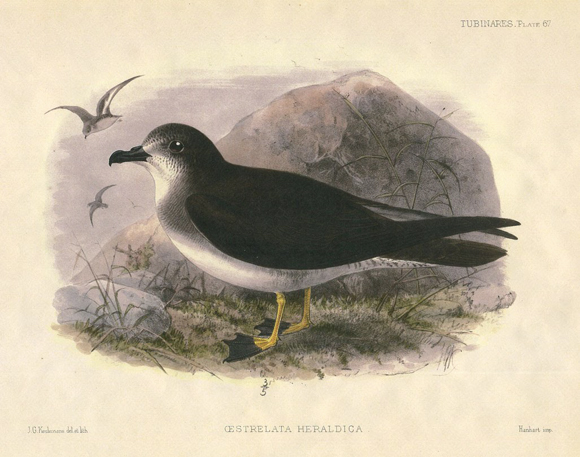
John Gerrard Keulemans
1842-1912
The Herald Petrel in light morph (illustration) has mid grey-brown plumage, with head and neck showing a strong contrast with the whitish underparts.
On the upper breast, we can see a diffuse, dark breast band of variable size. The area from lower breast to undertail-coverts is whitish with variably darker flanks and undertail-coverts.
On the underwing, the basic pattern is similar to dark morph, but it is more variable in light morph.
The forked tail show greyish tones, often visible in flight.
On the head, we can see a white area at base of the bill, including variably forehead, lores and chin.
The short bill is black. It is robust with hooked tip and prominent tube on the top.
The eyes are dark brown, but mostly black in nestlings.
Legs and webbed feet are dull pink-coloured, with black outer toes and webs.
Male and female are similar in appearance, but the female is slightly smaller than the male.
The juvenile resembles adults. It has sharp black claws, becoming duller with age.
RANGE:
The Herald Petrel occurs mainly in the South Pacific Ocean. It is a colonial nester, and the colonies are established on numerous tropical South Pacific islands, from N Australia, E across Polynesia, including Raine Island in NE Queensland with about 1,000 pairs, Chesterfield Reefs (New Caledonia), Tonga, Cook, Marquesas, Tuamotu, Gambier, Pitcairn and Easter.
Small numbers are known to breed on Round Island (Mauritius), and also on Cousin Island in the Seychelles.
Significant nesting populations also occur on the Chatham Islands (New Zealand), and in the remote Australian waters.
During the non-breeding period, the Herald Petrel disperses throughout the tropical and subtropical region of the Pacific Ocean. It usually remains far offshore or near mid-oceanic islands.
The species also occurs in the North Pacific around Hawaii, mainly from August to March, possibly year-round.
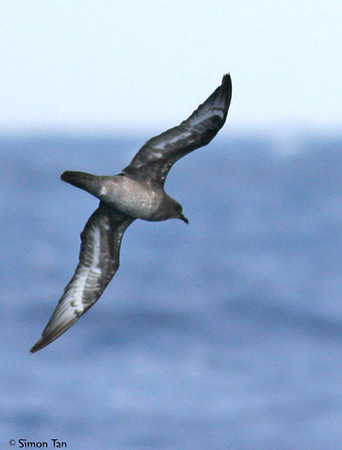
HABITAT:
The Herald Petrel is pelagic, and comes ashore only to breed, usually on oceanic islands, atolls and offshore stacks.
The species is known as a cavity-nester, although it could be sometimes a surface-nester, depending on the habitat.
Usually, the nest is placed in rock crevice, on rocky cliffs, on ledges and ridges, and rocky slopes, often protected by trees or low vegetation, or overhanging rocks. The nest-site is found from near sea level to 1,000 metres above the water.
CALLS AND SONGS: SOUNDS BY XENO-CANTO
The Herald Petrel is usually vocal during the breeding season. It gives harsh, grating calls that resonate during this period. These calls reflect the strong pair bonds between mates.
At night at the colonies, the birds produce rapid staccato series of squeaky chatter. These calls are uttered at varying speeds and sometimes resemble dolphin clicks or peals of laughter.
On Raine Island (NE Queensland), the intermediate morph produces a mew call described as a drawn-out, low-pitched nasal note. It is used as an alarm or distress signal.
BEHAVIOUR IN THE WILD:
The Herald Petrel feeds primarily on small fish, squid and crustaceans. The prey are caught by contact-dipping, surface-plunging or aerial pursuit. The bird glides over vast stretches of ocean while searching for food.
It may associate with other seabirds when foraging, especially the Wedge-tailed Shearwater and the Juan Fernandez Petrel.
The diet of the chicks also includes insects such as sea skaters.
The Herald Petrel has very social behaviour during the breeding season. The birds are often seen in small/medium groups while performing aerial displays together.
The courtship rituals involve complex flight patterns and vocalizations, used to strengthen the pair bonds. The aerial displays consist of high-speed synchronised dives and loops over the breeding sites.
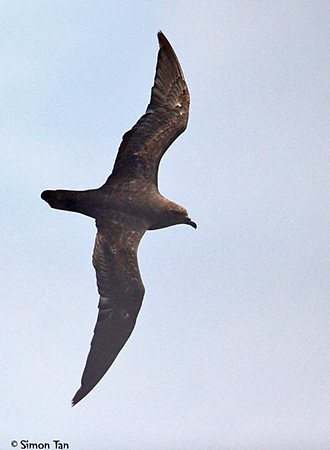
This species shows strong fidelity to mate and nesting site. It is a colonial nester.
It visits the breeding islands by day and remains silent, but it can be heard at night at the colonies. It nests in rock crevice or shallow scrape under low vegetation. A single egg is laid, and both parents share the nesting duties.
The Herald Petrel adult seems to be fairly sedentary, but immatures disperses over tropical and subtropical waters of Pacific Ocean.
Some colonies are deserted during some months. The species is reported in North Pacific in October-January, as far north as 39°N, and south to about 30°S, and east to the Peru Current off CW South America. At-sea status is poorly known.
However, the species is rare to spot during migration.
The Herald Petrel, and more generally numerous seabirds, are renowned for their elegant flight.
It performs a characteristic gliding flight, often low over the water surface. The long wings allow the bird to take advantage of ocean winds.
It is an elegant flyer, often covering hundreds of kilometres while searching for food. With such gliding flight, the present species is a master of the winds!
REPRODUCTION OF THIS SPECIES:
The breeding season of the Herald Petrel varies depending on the range. On Raine Island (NE Australia), they breed from July to September.
The species is a colonial nester, forming loose colonies on oceanic islands and atolls. The nest is placed on rock crevice, on ledges or ridges on rocky cliffs, also under trees, ferns or low vegetation on grassy slopes, or in shallow depression on the ground. The nest can be found from near sea level to 1,000 metres of elevation on cliffs.
The female lays a single white egg, and both adults take turns and share the incubation. The duration of this period is unknown, but the nesting period can be lengthy, around 70-80 days, allowing the complete development of the young bird.
At hatching, the chick is covered by dark grey down and the eyes are black. Both parents make frequent foraging trips to feed the young.
The birds visit the breeding islands by day, and they remain silent to avoid predation by invasive species on some islands. At night, they are more vocal and produce series of squeaky chatter.
